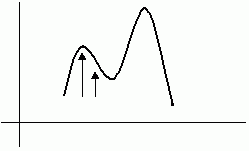
There’s a method of calculating the value of a mathematical function that starts with a guess of the value, and then iteratively tries to improve it. It works fine as long as the initial guess is good enough, but there are some functions where if the initial guess is wrong, it appears as if the function converges on the answer, but it is in fact only a local optimal value, and not the optimal value.
Designing a user interface can be similar. People don’t behave as we expect them to, so we make a first guess at an interface based on our expectations, and then user test and try to iteratively improve the interface – get it closer to how people really are – until we can’t get it any better.
An underlying problem though is that initial guess. It had better be close to how people really are, because otherwise the user testing might improve the interface, but it won’t find the optimal interface.
Which means that we have to observe before designing an interface, as well as user-test after designing it: we have all sorts of prejudices and stereotypes about how people are, formed by experiences with our own small circle of friends, family or colleagues, or through the media, which mislead us into making assumptions which may or may not be true. User testing isn’t going to undo those assumptions: only true observation can do that.
© Copyright Steven Pemberton, Amsterdam, 1999. All rights reserved.
First published in ACM/Interactions, November 1999